
#safety #airbagmoto #equipementmotard
Variable intake, adjustable mapping, anti-dribble clutch: there are many innovations from motorcycle racing that have found their way into our everyday motorcycling lives. The motorcycle airbag is the latest addition to this long list. And while the chances of you crashing into a pile of gravel at 300km/h are slim, this technology will protect you just as well on your Sunday outings. What are the criteria for choosing this equipment? Electronic or wired airbag? With or without subscription? Here's some information to help you make the right choice.
How does a motorcycle airbag work?
A motorcycle airbag works in exactly the same way as a car airbag. In the event of an accident, airbags inflate rapidly to cushion the impact. The difference with a car? When you're on the bike, the airbag dresses you up. Whether worn as a vest, integrated into your jacket or wetsuit, you're always wearing these beneficial air cushions, located in sensitive areas of the body such as the abdomen, cervical vertebrae and spine.
![]()
A motorcycle airbag is made up of three key components:
Inflatable bags distributed over the upper body, a gas cartridge (CO2 or Argon, depending on the manufacturer) to fill them, and a sensor to trigger the device (ideally at the right moment).
![]()
The ultimate criterion for choosing a motorcycle airbag:
Speed of reaction. That's right, the airbags need to fill with air while you're gliding, not after you've landed on the hood of the car that cut you off. What response time should I opt for? Between 20 and 100 ms. Not beyond!
Wired or electronic airbag: 2 detection modes for safe driving
How do you trigger the airbag at the right moment? What detects a fall? There are two schools of thought here: wired and electronic. Let's take a look at the pros and cons.
![]()
Let's start with the low-tech par excellence: the wired airbag.
The principle is rudimentary: a cable connects your vest to your bike. In the event of an unintentional Triple Axel, this link is torn, triggering the airbags to inflate. No batteries, electronics or subscriptions - it's primitive but effective. And yet, this technology is tending to disappear.
But why? First of all, let's dispel a common misconception: the risk of unexpected triggering is extremely low. You really need to pull hard on the cable to trigger it. Which means? If you forget to disconnect your airbag during a bathroom break, gas stop or photo stop, you don't run the risk of going into Michelin Man mode.
On the other hand, if you fall while stationary, there's a good chance your airbags will fill with air. Above all, the wired release offers poor protection in the event of a low-side. What's a low-side? When you're cornering and the front wheel loses grip. In this situation, you gently accompany the bike into the fall. As you're not thrown off, your airbag doesn't go off.
And off-road? This is where the device shows its limitations. In fact, there can be many low-speed crashes that don't need to be triggered (read my adventures on the Gibraltar to see for yourself). And above all, the presence of a cable constantly connecting you to your trail is not particularly practical.
In conclusion, while the wired airbag is quite effective for on-road use, it's less suitable for track use, and even less so for off-road.
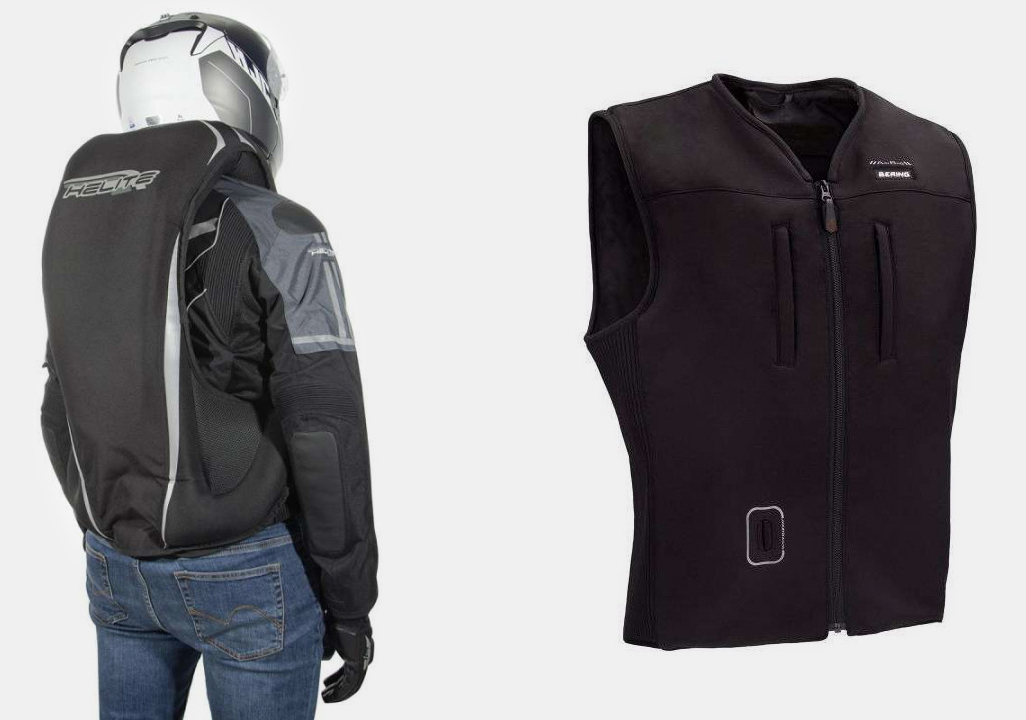
----> HELITE TURTLE 2 Airbag Vest Black
----> Bering C-PROTECT AIR LADY women's airbag vest
![]()
Second school: the electronic airbag
The principle is simple: this airbag vest (or jacket) incorporates sensors to detect dubious cornering or deceleration that's a little too sudden to be simply hard braking. A computer then analyzes this data and determines when to trigger inflation.
The advantages of this technology? The vest is completely autonomous, independent of the bike; reaction time is ultra-fast (between 20 and 80ms); the algorithm prevents any unexpected triggering (or let's say 99% of them, that's on the margin).
The only fly in the ointment? The on-board computer needs power to operate. And yeah, it's not running on biker sweat just yet. So the vest comes with an internal battery. And battery life means autonomy. Depending on the model, you can expect between 20 and 30 hours of riding before you need to recharge your airbag's batteries.
![]()
What about radio-controlled airbags?
This technology, originally developed by Bering, is tending to disappear. In fact, the idea was to place the sensor on the motorcycle, rather than on the rider. On paper, it's intelligent, because in the event of an impact, the motorcycle reacts before the rider. And, incidentally, it's probably the most effective device for protecting you when you're hit from a standstill.
But then? The reaction time wasn't incredible, and above all, the airbag was dependent on the bike. As a result, the airbag that relied solely on a sensor placed on the motorcycle no longer exists.
However, this precious sensor has not said its last. Today, it is still used, but only as a complement to a stand-alone airbag (which is no longer really a stand-alone airbag), as for example Helite's E-Turtle 2.
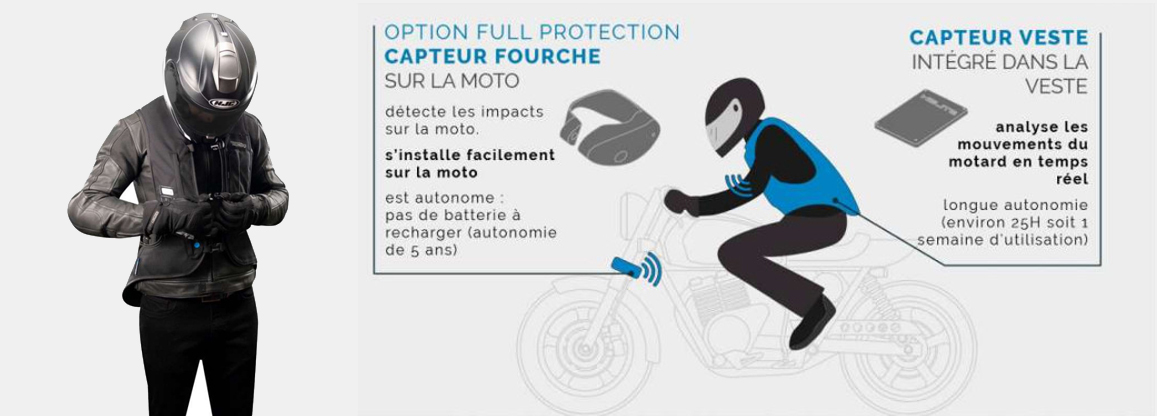
What's the budget for a motorcycle airbag? With or without subscription?
The purchase price is obviously an important criterion when selecting an airbag model.
But what about? You also need to factor in the cost of a possible subscription to this budget. To clarify this murky subscription issue, let's take a look at In&motion, the market leader in motorcycle airbags. This French company has developed an ingenious, battery-powered microcomputer. Combined with sensors and accelerometers, its ultra-precise algorithm can trigger an airbag very quickly. So what does it mean? Rather than reinvent the wheel, some equipment manufacturers have decided to use this technology. For example, Ixon, Klim, Furygan, RST and Held vests feature an In&motion calculator.
The advantage for the consumer? You can use the same box for different products. So, if you decide to swap your valiant Ixon vest for another from Klim, you can use the same In&Box with a single subscription. Ditto if you have, say, a track suit, a road vest and a third product for off-road use (okay, that's overstating it, but you get the idea).
![]()
Okay, but why on earth pay for a subscription?
Several reasons have been put forward: the automatic call for help in the event of a trigger, software updates and a lifetime warranty on the box.
It may also be thought that this strategy limits the sharing of units. Each box is paired with an airbag and linked to a specific customer account. It therefore seems complicated to lend your box when you're not using it, for example. The In&Motion subscription costs €12/month. It is also possible to buy the In&Box instead of renting it, for a fee of 400€ (in this case, you don't need to call for help, and the box comes with a lifetime warranty).
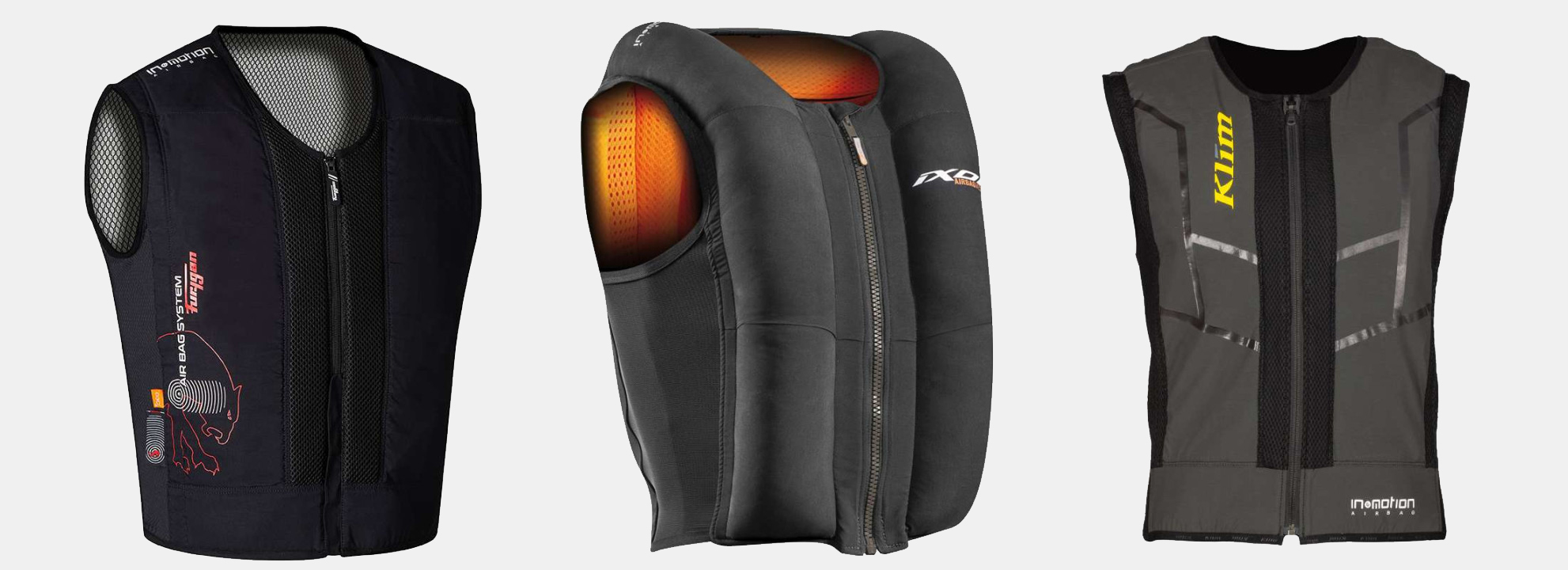
----> Furygan UNIVERSAL SYSTEM airbag vest
----> Airbag vest Ixon IX-AIRBAG U03
![]()
Do all brands use In&Motion? No.
Bering, for example, is in a class of its own, choosing to develop its own detection technology: E-protect. The offer is very similar to that proposed by In&motion, i.e. €12/month rental (with automatic emergency call) and €300 purchase.
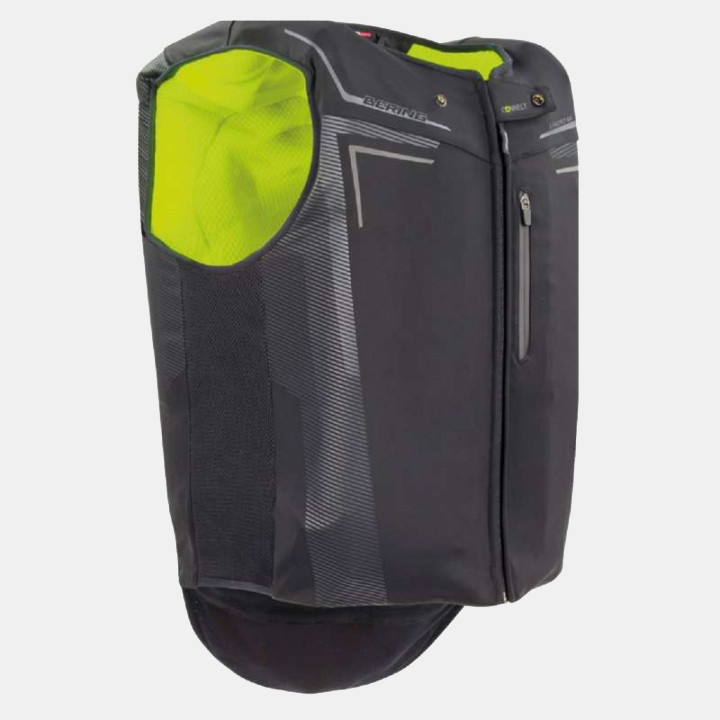
----> Bering E-PROTECT AIR airbag vest
![]()
Options without subscription
Does the idea of "subscribing" for protection sound cold to you? Rest assured, there are alternatives (besides good old wired). Alpinestars has developed a "Tech air" subscription-free solution, Dainese the "D-Air" technology and Helite (a French brand) the "Turtle" airbag device. As you can see, these stand-alone, no-subscription models are more expensive to buy, but they don't come at a premium later on.
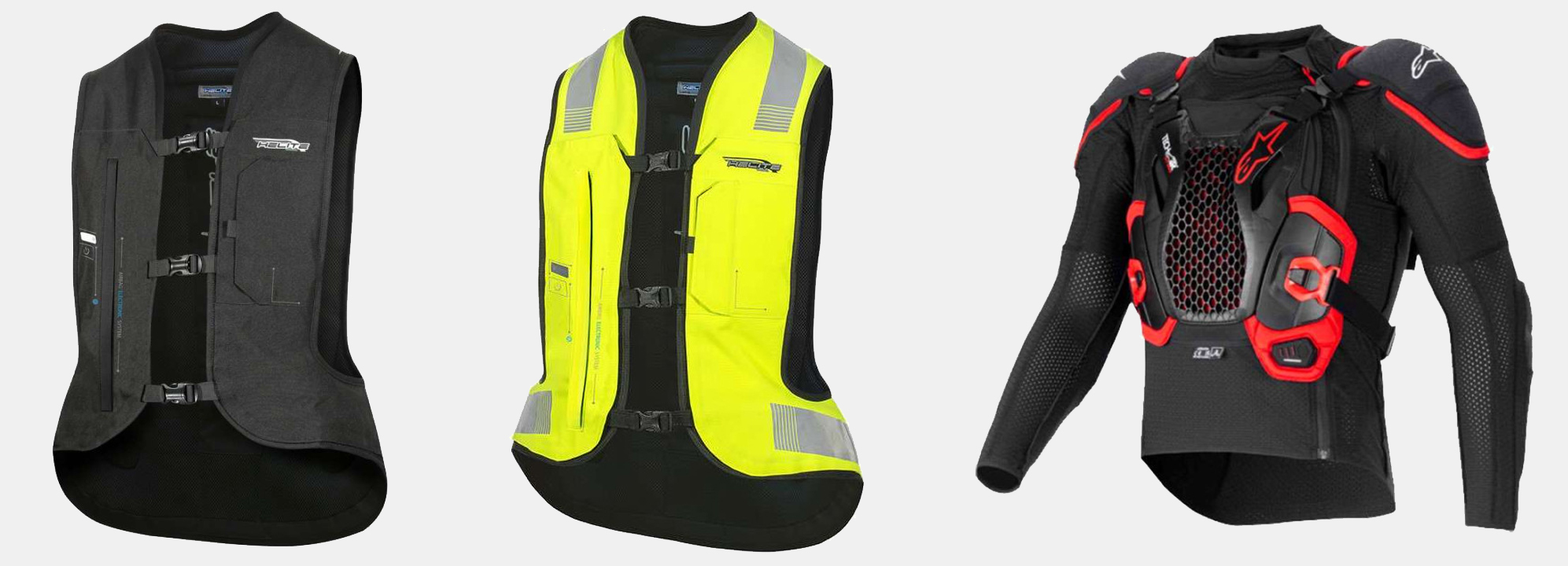
----> HELITE E-TURTLE 2 airbag vest
How to wear a motorcycle vest
There are currently three airbag devices on the market : the racing suit, the motorcycle jacket and the vest. While the first two raise no questions, let's look at the use of the latter.
![]()
Is an airbag vest worn over or under the jacket?
Both are possible. However, we recommend wearing the vest over the jacket, as this allows you to enjoy the benefits of airbag inflation without strain. Cervical spine, thorax, spinal column and abdomen: all these sensitive areas are optimally protected. Why is it more restrictive to wear your airbag vest under your jacket? Because you have to make sure it's compatible. And yes, it must under no circumstances prevent the balloons from deploying fully. Indeed, it's easy to imagine that a slim-fitting motorcycle jacket - and one with a thermal inner lining - leaves little room for inflated airbags.
![]()
And that's where we have to be vigilant when it comes to vests: compatibility.
With the jacket, of course, but also with other accessories such as a rucksack, a stone shield, a heated vest or a back protector. Because of its rigidity, the latter will compromise airbag deployment. How do you know what's compatible? By studying your vest's instructions, such as this instructive literature from In&Motion.
![]()
The vest has one undeniable quality: modularity.
Whether you're wearing your winter jacket, your summer jacket, your track suit or your off-road jersey, you can put on the same airbag vest. Which leads us naturally to the next chapter.
![]()
How about a motorcycle jacket with integrated airbag?
Now that we've raised the question of compatibility, you might be wondering whether it wouldn't be a good idea to opt for a motorcycle jacket with an airbag already included. Its main advantage? The integration of this device is obviously ideal. However, these jackets are obviously more expensive. And in the event of serious damage following a prolonged slip, you'll have to change your jacket AND your airbag.

Which airbag for off-road and on-road use?
Motorcycle airbags dedicated to off-road riding
Could it be that the airbag lobby is pulling the wool over your eyes? Hell no! The reason is simple: the algorithm used to detect a fall is not the same whether you're riding on the road, on the track or in an enduro. As you'll have gathered, in this section we'll be leaving wired vests behind, and turning our attention to autonomous electronic models.
Indeed, each riding mode has its own specificities. On the road, for example, it's easy to imagine that the biker leans a little less than Marquez and that the 0 to 100 is not as stratospheric as in Moto GP. And yet? Even with angles and speeds that vary "reasonably" slowly, the road algorithm required years of development.
Off-road? It's even trickier, because it's all over the place. Vibrations are high, the rider's body moves without logic, and angle changes are fast and random. The detection software therefore needs to be more "tolerant" of micro-movements. And most importantly? A loss of balance at low speed need not trigger the airbag.
----> Alpinestars TECH AIR OFF-ROAD airbag vest
![]()
What about airbags for track use?
It's even more interesting, since cornering is extreme and braking violent. And while a high-side is easy to detect, this is not the case for its counterpart: the low-side. In other words, a loss of front tire grip when cornering. The difficulty? When the rider falls, his sliders are already rubbing. He's already almost on the ground, with his torso at an angle. This makes it difficult to detect a fall quickly and effectively.
In&Motion offers road vests incorporating a circuit-oriented algorithm. Helite segments its products by offering a "track" vest designed to be worn under a wetsuit (close-fitting cut, clear space for the bump, etc.). In fact, for maximum protection on the track, we recommend that you opt for a suit with an integrated airbag. Of course, this comes at a price, but let's not forget that physical integrity is priceless.
Can you use your "road" airbag vest on tracks and off-road?
Yes and no (nice answer from Normand). Let me explain. As we've seen, the algorithm must differ according to use. That's why In&Motion has developed 3 distinct detection modes (road, track and adventure). As a result, airbags equipped with their technology are multi-purpose - for an additional subscription fee. So, off to the Dakar then? Hell, no! Because when In&Motion says "Adventure", it means trail riding. This excludes enduro riding, and even more so cross-country riding with all the jumps that entails.
And what about the competition? Alpinestars has developed the Tech-Air Off-road model, which offers 3 detection modes: Rally, Enduro and Road (no trails). Resolutely off-road oriented, it offers the advantage of being portable for outings on good old asphalt. Helite is also playing the specialization card, with several models designed for off-road use. Well ventilated and in no way hindering freedom of movement, they offer 2 algorithm sensitivities: Rallye/Enduro and Trail.
![]()
.jpg)
Can a motorcycle airbag vest be reused after a crash?
At over €600 for an airbag vest, you'd hope to be able to reuse it after a trigger. But is this really the case? Well, that depends on the manufacturer - there's no general rule.
At Helite, as long as the vest has no holes or tears, it's reusable after activation. How do I proceed? It's as simple as changing the CO2 cartridge.
Dainese's D-airtechnology allows 3 activations before having to go to an authorized dealer for reconditioning.
Conversely, with Alpinestars, any deployment on a road model means a return to an Alpinestars center for reconditioning. In addition, after three inflations, the air cushions are also replaced. The exception? The Tech-Air Off-Road technology. In fact, airbags equipped with this technology have a double charge capacity, enabling two separate activations. Well, these models were developed for the Dakar Rally, so that explains it. What's more, on these products, you can replace the gas cartridge(s) yourself after inflation (up to a maximum of three times).
What's more, the Alpine Stars airbag vest is the only one that's washable. All you have to do is remove the electronics and balloons. It's a tedious operation, but it's worth the effort.
And what about the leader in motorcycle airbags? Well, In&Motion provides a detailed procedure for refurbishing your vest after a trigger. All you need to do is buy a new gas cartridge (Inflator), and follow the step-by-step tutorial.
We hope you've found this article useful. The most important thing to remember? A motorcycle airbag costs money. But neck braces are harder to replace than a C02 cartridge. And while this technology is still in its infancy, innovations are coming thick and fast. We can only hope that the democratization of the motorcycle airbag will lead to a reduction in its cost.
.
.
.
.
.
Image credit: motorcycle image on track www.freepik.com
Our last posts
#interviewmotarde #etonvaoumaintenant #motardevoyageuse #voyagemoto
#hivernale #millevaches #équipementmotard #aventuresmichel
#aventuresmichel #hardefitour #raidenduro #tout-terrain
Aucun produit
